![C. W. Arldt [de]: Lime tree in Kaditz, c. 1840 Kaditzer Linde, 1840.jpg](http://upload.wikimedia.org/wikipedia/commons/thumb/1/14/Kaditzer_Linde%2C_1840.jpg/220px-Kaditzer_Linde%2C_1840.jpg)
The lime tree, or linden, ( Tilia ) is important in the mythology, literature, and folklore of a number of cultures.
![C. W. Arldt [de]: Lime tree in Kaditz, c. 1840 Kaditzer Linde, 1840.jpg](http://upload.wikimedia.org/wikipedia/commons/thumb/1/14/Kaditzer_Linde%2C_1840.jpg/220px-Kaditzer_Linde%2C_1840.jpg)
The lime tree, or linden, ( Tilia ) is important in the mythology, literature, and folklore of a number of cultures.

In old pagan Slavic mythology, the linden (lipa, as called in all Slavic languages) was considered a sacred tree. [1] In Poland, the village of Święta Lipka, which literally means "Sacred Lime Tree", has a shrine and is a pilgrimage destination. [2] To this day, the tree is a national emblem of the Czech Republic, Slovakia, [3] Slovenia, [4] and of the Sorbs in Lusatia. [5] Lipa gave name to the traditional Slavic name for the month of June (Croatian, lipanj) or July (Polish, lipiec, Ukrainian "lypen'/липень"). It is also the root for the German city of Leipzig, taken from the Sorbian name lipsk. [6] The former Croatian currency, kuna , consisted of 100 lipa (Tilia). "Lipa" was also a proposed name for Slovenian currency in 1990, however the name "tolar" ultimately prevailed. [7] In the Slavic Orthodox Christian world, limewood was the preferred wood for panel icon painting. The icons by the hand of Andrei Rublev, including the Holy Trinity (Hospitality of Abraham), and The Savior, now in the State Tretyakov Gallery in Moscow, are painted on linden wood. Its wood was chosen for its ability to be sanded very smooth and for its resistance to warping once seasoned. The southern Slovenian village of "Lipica" signifies little Lime tree and has given its name to the Lipizzan horse breed. [8]
In Baltic mythology, there is an important goddess of fate by the name of Laima /laɪma/, whose sacred tree is the lime. Laima's dwelling was a lime-tree, where she made her decisions as a cuckoo. For this reason Lithuanian women prayed and gave sacrifices under lime-trees asking for luck and fertility. They treated lime-trees with respect and talked with them as if they were human beings.

The linden was also a highly symbolic and hallowed tree to the Germanic peoples in their native pre-Christian Germanic mythology.
Originally, local communities assembled not only to celebrate and dance under a linden tree, but to hold their judicial thing meetings there in order to restore justice and peace. It was believed that the tree would help unearth the truth. Thus the tree became associated with jurisprudence even after Christianization, such as in the case of the Gerichtslinde , and verdicts in rural Germany were frequently returned sub tilia (Unter der linden) until the Age of Enlightenment.
In the Nibelungenlied , a medieval German work ultimately based on oral tradition recounting events amongst the Germanic tribes in the 5th and 6th centuries, Siegfried gains his invulnerability by bathing in the blood of a dragon. While he did so, a single linden leaf sticks to him, leaving a spot on his body untouched by the blood and he thus has a single point of vulnerability.
The most notable street in Berlin, Germany, is called Unter den Linden , named after the trees lining the avenue. It leads from the center of Berlin to Potsdam, the country residence of the Prussian kings.
In German folklore, the linden tree is the "tree of lovers". The well-known Middle High German poem Under der linden by Walther von der Vogelweide (c. 1200) describes a tryst between a maid and a knight under a linden tree. Commentary on the folk song "Liebesprobe" states, "The linden tree plays a key role in these songs; at eventide, the lovers caress in its shade, it is their favourite tree, and perhaps for the reason that the linden leaf has the shape of a human heart." [9]
Hohenlinden (translated as "High linden") is a community in the upper Bavarian district of Ebersberg in which the Battle of Hohenlinden took place; Thomas Campbell wrote the poem "Hohenlinden" about said battle.
Homer, Horace, Virgil, and Pliny mention the linden tree and its virtues. As Ovid tells the old story of Baucis and Philemon, she was changed into a linden and he into an oak when the time came for them both to die. Herodotus says: "The Scythian diviners take also the leaf of the linden tree, which, dividing into three parts, they twine round their fingers; they then unbind it and exercise the art to which they pretend. [10] Philyra, mother of the centaur Chiron, turned into a linden tree after bearing Chiron.
For a long time, in northern China, because there is no Bodhi tree, the sacred tree of Buddhism, and the leaf shape of the "椴樹/Tilia" tree is similar to that of Bodhi tree, it was planted in temples to replace the sacred Bodhi tree. They are also often called Bodhi trees, just like the two Tilia trees next to the 英華殿/Yinghua Dian—the place where the empress dowager, empress and concubines worship Buddha—in the Forbidden City in Beijing, planted by Empress Dowager Li, the biological mother of Wanli Emperor about five hundred years ago. [11] Qianlong Emperor of the Qing dynasty even wrote two poems for them: "菩提树诗/The Poem of the Bodhi Tree (in the Yinghua Dian)" and "菩提树歌/The Song of the Bodhi Tree (in the Yinghua Dian)", and carved them on stone tablets and placed them in the stele pavilion in front of the Yinghua Dian. [11]
J. R. R. Tolkien composed the poem "Light as Leaf on Lindentree" which was originally published in 1925 in volume 6 of The Gryphon magazine. After many emendations it was later included in The Lord of the Rings as a song sung by Aragorn about the tale of Beren and Lúthien.
A play called The Linden Tree (1947) was written by Bradford-born English novelist, playwright and broadcaster J. B. Priestley.
Samuel Taylor Coleridge features linden trees as an important symbol in his poem "This Lime-Tree Bower My Prison" (written 1797; first published 1800).
Several of the short poems (Fraszki) of Polish poet Jan Kochanowski feature the linden. His "Na Lipę" ("To The Tilia Tree"), published in 1584, was inspired by a much-favoured tree on his country estate at Czarnolas. Kochanowski contemplated, rested and wrote in its shade, and offered refreshment to guests under its shelter, and these moments were all represented in his poetry. [12]
A poem from Wilhelm Müller's Winterreise cycle of poems is called "Der Lindenbaum" ("The Linden Tree"). In 1827, Franz Schubert wrote the famous song cycle "Winterreise" (D 911) based on these poems. In Thomas Mann's novel The Magic Mountain , a recording of this song cycle is an important plot device and philosophical touchstone.
Hans Christian Andersen's short story "The Elf of the Rose" mentions a linden tree and its leaves frequently.
In The Grimm Brothers' fairy tale The Frog Prince , the princess drops her golden ball into the pond while sitting under a linden tree.
Goethe's The Sorrows of Young Werther features a linden tree throughout the novel, and the protagonist, Werther, is buried under the tree after his suicide.
In Swann's Way , the first book of Proust's In Search of Lost Time , the narrator dips a petite madeleine into a cup of lime-blossom tea. The aroma and taste of cake and tea triggers his first conscious involuntary memory.
"The Three Linden Trees" is a 1912 fairy tale by Hermann Hesse strongly influenced by the Greek legend of Damon and Pythias. The story, set in the medieval period, tries to explain three huge linden trees whose branches intertwine to cover the entire cemetery of the Hospital of the Holy Spirit in Berlin (see The Complete Fairy Tales of Hermann Hesse).
John Updike's novel The Centaur , like James Joyce in Ulysses, uses myth in an attempt to turn a modern and common scene into something more profound, a meditation on life and man's relationship to nature and eternity. In it Updike parallels the lives of modern characters with the Greek myth in which Chiron's mother Philyra transforms into a linden tree to escape the shame of giving birth to a seemingly mutant half-horse, half-man as a result of her being raped by Cronus. [13]
The lime tree is referred to in the 1953 story "The Man Who Planted Trees" by Jean Giono. The unnamed narrator of the story re-visits a once abandoned and desolate village around which the man referenced by the books title (Elzéard Bouffier) has planted a forest over a period of 40 years. He returns to find by the fountain: "I saw that there was indeed a fountain, that it was abundant, and, which touched me most, that someone had planted a lime tree next to it, which might already have been four years old, already thick; an undeniable symbol of resurrection. [14]
Eminescu's Linden Tree (Romanian : Teiul lui Eminescu) is a 500-year-old silver lime situated in Iași, Romania. Mihai Eminescu reportedly wrote some of his best works underneath this lime, rendering the tree one of Romania's most important natural monuments and an Iași landmark. [15]
Ralph Vaughan Williams wrote the song "Linden Lea" in the 1900s.
The coat of arms of Mariehamn features lime tree leaves, referring to the local tree plant. [16] [17] [18] [19]
O-Zone's 2003 song "Dragostea din tei" (Love from the Linden) is titled after the tree.
Trevor Hall's 2009 song "The Lime Tree" was named for the tree and is based on Ovid's narration of Baucis and Philemon and the poem "Under der linden" by Walther von der Vogelweide.
In Sweden, where the lime tree is named "Lind", the 100 most common surnames in 2015 included at 17 Lindberg (Lime-hill), at 21 Lindström (Lime-stream), at 22 Lindqvist (Lime-twig), at 23 Lindgren (Lime-branch), and at 99 Lindholm (Lime-island). [20]
Latvian mythology is the collection of myths that have emerged throughout the history of Latvia, sometimes being elaborated upon by successive generations, and at other times being rejected and replaced by other explanatory narratives. These myths, for the most part, likely stem from Proto-Indo-European practices and the later folk traditions of the Latvian people and pre-Christian Baltic mythology.

Mihai Eminescu was a Romanian Romantic poet, novelist, and journalist from Moldavia, generally regarded as the most famous and influential Romanian poet. Eminescu was an active member of the Junimea literary society and worked as an editor for the newspaper Timpul, the official newspaper of the Conservative Party (1880–1918). His poetry was first published when he was 16 and he went to Vienna, Austria to study when he was 19. The poet's manuscripts, containing 46 volumes and approximately 14,000 pages, were offered by Titu Maiorescu as a gift to the Romanian Academy during the meeting that was held on 25 January 1902. Notable works include Luceafărul, Odă în metru antic, and the five Letters (Epistles/Satires). In his poems, he frequently used metaphysical, mythological and historical subjects.
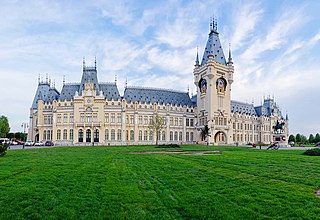
Iași, also referred to mostly historically as Jassy, is the third largest city in Romania and the seat of Iași County. Located in the historical region of Moldavia, it has traditionally been one of the leading centres of Romanian social, cultural, academic and artistic life. The city was the capital of the Principality of Moldavia from 1564 to 1859, then of the United Principalities from 1859 to 1862, and the capital of Romania from 1916 to 1918.
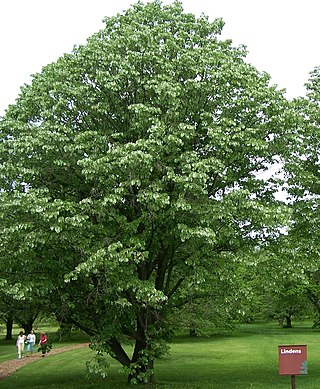
Tilia is a genus of about 30 species of trees or bushes, native throughout most of the temperate Northern Hemisphere. The tree is known as linden for the European species, and basswood for North American species. In Great Britain and Ireland they are commonly called lime trees, although they are not related to the citrus lime. The genus occurs in Europe and eastern North America, but the greatest species diversity is found in Asia. Under the Cronquist classification system, this genus was placed in the family Tiliaceae, but genetic research summarised by the Angiosperm Phylogeny Group has resulted in the incorporation of this genus, and of most of the previous family, into the Fabaceae.

Ľudovít Štúr, also known as Ľudovít Velislav Štúr, was a Slovak revolutionary, politician, and writer. As a leader of the Slovak national revival in the 19th century, and the author of the Slovak language standard, he is lauded as one of the most important figures in Slovak history.
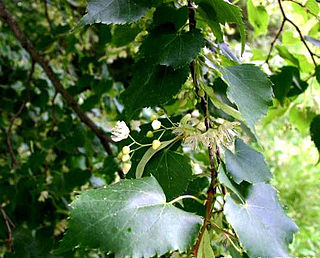
Tilia cordata, the small-leaved lime or small-leaved linden, is a species of tree in the family Malvaceae, native to much of Europe. Other common names include little-leaf or littleleaf linden, or traditionally in South East England, pry or pry tree. Its range extends from Britain through mainland Europe to the Caucasus and western Asia. In the south of its range it is restricted to high elevations.
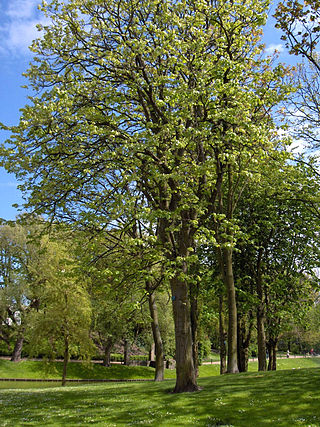
Tilia platyphyllos, the large-leaved lime or large-leaved linden, is a species of flowering plant in the family Malvaceae (Tiliaceae). It is a deciduous tree, native to much of continental Europe as well as southwestern Great Britain, growing on lime-rich soils. The common names largeleaf linden and large-leaved linden are in standard use throughout the English-speaking world except in the British Isles, where it is known as large-leaved lime. The name "lime", possibly a corruption of "line" originally from "lind", has been in use for centuries and also attaches to other species of Tilia. It is not, however, closely related to the lime fruit tree, a species of citrus.

The Nixie, Nixy, Nix, Näcken, Nicor, Nøkk, or Nøkken are humanoid, and often shapeshifting water spirits in Germanic mythology and folklore.

The Balto-Slavic languages form a branch of the Indo-European family of languages, traditionally comprising the Baltic and Slavic languages. Baltic and Slavic languages share several linguistic traits not found in any other Indo-European branch, which points to a period of common development and origin.

Václav Hanka was a Czech philologist.

Fohren-Linden is an Ortsgemeinde – a municipality belonging to a Verbandsgemeinde, a kind of collective municipality – in the Birkenfeld district in Rhineland-Palatinate, Germany. It belongs to the Verbandsgemeinde of Baumholder, whose seat is in the like-named town.

Südfriedhof is, with an area of 82 hectares, the largest cemetery in Leipzig. It is located in the south of Leipzig in the immediate vicinity of the Völkerschlachtdenkmal. The Südfriedhof is one of the largest rural cemeteries in Germany, along with the Ohlsdorf Cemetery in Hamburg and the Stahnsdorf South-Western Cemetery in Berlin.
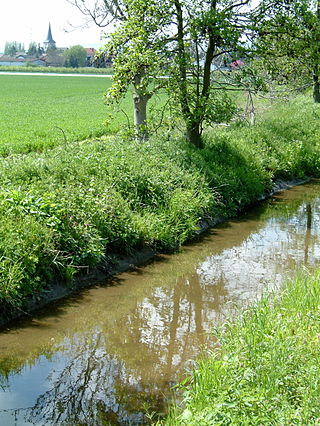
The Eckbach is a small river in the northeastern Palatinate and the southeastern Rhenish Hesse. It is slightly over 39 kilometres (24 mi) long.

The lime tree of Kaditz is a natural landmark situated in the churchyard of Emmaus Church in Kaditz, a district of Dresden in Saxony, Germany. The large-leaved lime tree is 20 metres (66 ft) high and is estimated to be between 500 and 1,000 years old. The girth of the trunk is about 10 metres (33 ft). In 1818 the tree was badly damaged by a huge fire in the village, which caused the trunk to split in two. It developed an abnormal growth to compensate for the damage done by the fire. This lime tree has often been written about and depicted, especially in Germany, and has also been used as a case study in dendrology, the science of trees and wooded plants. With its large girth it was ranked among the biggest lime trees in Germany even in the 19th century. The Kaditz Lime is also said to have served as a kind of pillory in the Middle Ages. The German Tree Archive includes it in its list of the most significant trees in the nation, in which the most important criterion is the girth of the trunk measured at a height of 1 metre.

"Geh aus, mein Herz, und suche Freud" is a summer hymn with a text in German by the theologian Paul Gerhardt, written in 1653. It was first published in the same year in the fifth edition of Johann Crüger's hymnal, Praxis pietatis melica. The hymn was sung to several melodies, with the most popular one composed by August Harder. Later, it became a Volkslied in an abridged version.

Doina, or Doină, is a political poem by the Romanian Mihai Eminescu. It was first published in 1883 and is therefore seen by some as Eminescu's final work in verse, although it may actually be an 1870s piece, inspired or enhanced by the perceived injustice of the Berlin Treaty. A variation of the doina, picked up from Romanian folklore, it is noticeably angry to the point of rhetorical violence, a radical expression of Romanian nationalism against invading "foreigners", with additional hints of ecopoetry and "anti-technicist" discourse. Doina delineates the ideal geographical space of Greater Romania, at a time when Romanian-inhabited regions were divided between an independent kingdom and multinational empires. Its final lines call on Stephen the Great, depicted as a sleeping hero, to take up the cause of Romanians and chase foreigners out with the sound of his horn. The same basic themes appear in another poem by Eminescu, the anthem-like La arme, which is sometimes discussed as a variant of Doina.

Das Lied vom Hürnen Seyfrid, or Hürnen Seyfrid for short, is an anonymous Early New High German heroic ballad. The poem concerns the adventures of young Siegfried, hero of the Nibelungenlied and an important figure in Germanic heroic legend. It preserves traditions about Siegfried that are otherwise only known from Old Norse sources and thus attest their existence in oral traditions about Siegfried that circulated outside of the Nibelungenlied in Germany.
Hugo Alexander Oelbermann was a German poet and bookseller. His pseudonyms were Hugo von Müllenbach, Ernst Thränenlacher, and Nath. Faust.

"Liebesprobe" is an old German folk song. Already before the 17th century the song appeared in some records in the form of a distich. A number of its versions are found in many later folklore collections, such as Des Knaben Wunderhorn (1806), Deutscher Liederhort (1893).